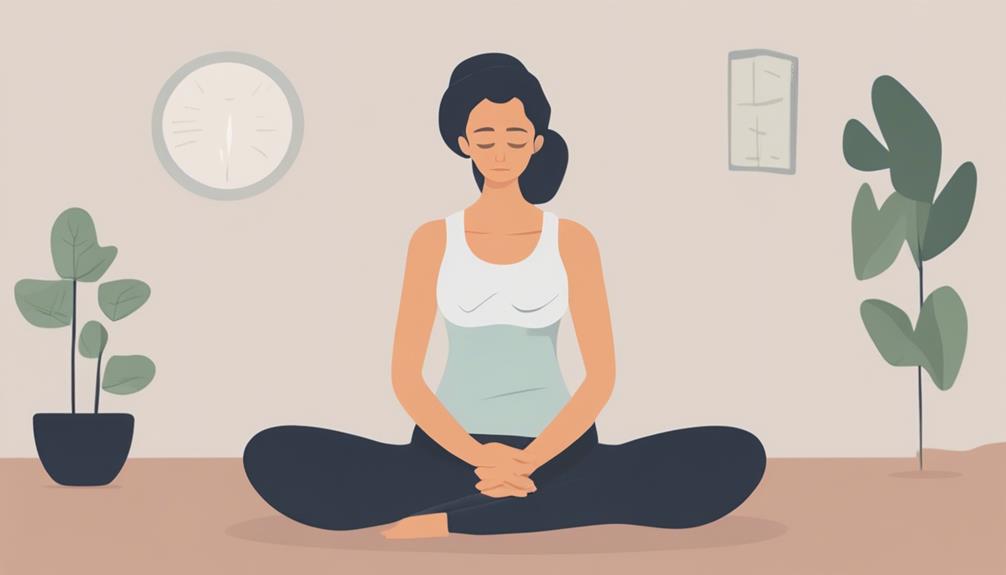Hypnosis Induction Techniques
5 Easy Self-Hypnosis Methods for Beginners
May 3, 2016 - Hypnosis Induction Techniques
Master self-hypnosis with these beginner-friendly methods. Start by calming the mind with deep breathing in a quiet space. Visualize your goals using creative imagery. Boost confidence with positive affirmations and reprogram limiting beliefs. Relax deeply by tensing and releasing muscle groups. Dive into guided imagery for immersive relaxation. Unlock the power of your subconscious mind with these simple techniques designed for beginners.
Breathing Techniques

One of the foundational elements in mastering self-hypnosis is employing proper breathing techniques to induce a state of relaxation and focus.
Deep breathing is a powerful tool that can help calm the mind and body, making it easier to enter a hypnotic state.
To begin, find a quiet and comfortable space where you won't be disturbed. Sit or lie down in a relaxed position and close your eyes.
Take a slow, deep breath in through your nose, allowing your lungs to fill completely. Hold the breath for a few seconds, then exhale slowly through your mouth, releasing any tension or stress you may be holding onto.
Repeat this deep breathing exercise several times, focusing on each inhale and exhale.
As you continue to breathe deeply, you will feel your mind relaxing, allowing you to enter a state of deep focus and receptivity to self-hypnosis techniques.
Mastering deep breathing for mind relaxation is key to enhancing your self-hypnosis practice.
Visualization Methods
Utilizing visualization techniques is a fundamental aspect of developing proficiency in self-hypnosis, enabling individuals to harness the power of mental imagery for deepening relaxation and accessing the subconscious mind.
Creative visualization involves creating detailed mental images to achieve specific goals or outcomes. Through manifestation techniques, individuals can visualize their desires with clarity, enhancing the likelihood of those desires becoming reality.
Mindful meditation is an essential component of visualization methods in self-hypnosis. By practicing mindful meditation, individuals can cultivate a heightened sense of awareness and focus, making it easier to engage in mental imagery techniques effectively.
These techniques involve vividly imagining desired scenarios or outcomes, tapping into the subconscious mind's potential for transformation and growth.
When incorporating visualization methods into self-hypnosis practices, it is crucial to create a peaceful and distraction-free environment. By dedicating time to regular visualization exercises, individuals can strengthen their ability to manifest positive changes in their lives through the power of focused mental imagery.
Positive Affirmations

Incorporating positive affirmations into your self-hypnosis practice can significantly enhance your ability to reprogram limiting beliefs and promote a mindset of empowerment and positivity.
Daily mantras, which are short, powerful statements repeated frequently, can serve as anchors during self-hypnosis sessions. These affirmations should be in the present tense, positive, and specific to your goals.
By incorporating daily mantras into your self-hypnosis routine, you can reinforce positive beliefs and cultivate a sense of self-worth and confidence.
Self-confidence boosts are another key aspect of positive affirmations in self-hypnosis. Affirmations focused on boosting self-confidence can help you overcome self-doubt and insecurities.
Phrases like 'I believe in myself' or 'I am worthy of success' can gradually shift your mindset towards one of self-assurance and courage.
When practiced consistently, these affirmations can rewire your subconscious mind and empower you to face challenges with resilience and optimism.
Progressive Muscle Relaxation
Progressive Muscle Relaxation is a technique that involves systematically tensing and then relaxing muscle groups in the body to induce a state of deep relaxation and reduce physical tension. This method is commonly used to alleviate stress, anxiety, and promote overall well-being.
To begin a progressive muscle relaxation session, find a quiet and comfortable space where you can sit or lie down. Start by taking a few deep breaths to center yourself, then systematically tense specific muscle groups in your body, such as your fists, arms, shoulders, and so on, holding the tension for a few seconds before releasing and allowing the muscles to relax completely.
As you go through each muscle group, focus on the sensations of tension release and relaxation. Conduct a body scan periodically to check for any residual tension and release it consciously.
Guided Imagery

Guided imagery involves using mental visualization techniques to create a vivid and detailed mental picture that can help induce relaxation and promote a sense of well-being. Through creative visualization, individuals can immerse themselves in an imagined environment, engaging multiple senses to enhance the experience.
This practice taps into the mind-body connection, where the brain interprets these mental images as real, triggering physiological responses similar to those experienced in the actual scenario. By envisioning calming scenes or positive outcomes, guided imagery activates the relaxation response in the body, leading to reduced stress levels and a greater sense of inner peace.
Research suggests that regular practice of guided imagery can have profound effects on both mental and physical well-being. It can help lower blood pressure, alleviate symptoms of anxiety and depression, and improve overall mood.
Frequently Asked Questions
Can Self-Hypnosis Help With Overcoming Specific Fears or Phobias?
Self-hypnosis can be an effective tool for overcoming specific fears or phobias such as public speaking or fear of flying and heights. By enhancing confidence and addressing underlying anxieties, individuals can gradually alleviate these challenges.
Is It Possible to Use Self-Hypnosis for Improving Sleep Quality?
Self-hypnosis can be a valuable tool in addressing sleep disorders by promoting relaxation and mental clarity. By incorporating insomnia techniques, individuals can create a calming bedtime routine that fosters improved sleep quality and overall well-being.
Can Self-Hypnosis Be Effective for Managing Chronic Pain?
Self-hypnosis can play a significant role in pain management for individuals with chronic conditions. By harnessing the power of the mind, it can help alleviate symptoms, promote relaxation, and improve overall well-being.
How Often Should Self-Hypnosis Sessions Be Practiced for Best Results?
The frequency of practice plays a critical role in the effectiveness of self-hypnosis. Consistency is key to yielding optimal results. Dedication to regular sessions enhances the benefits derived from self-hypnosis, allowing individuals to harness its full potential for personal growth and wellness.
Are There Any Potential Risks or Side Effects Associated With Self-Hypnosis?
Ethical considerations are vital in self-hypnosis to ensure user safety and well-being. Potential dangers include false memories or heightened anxiety. Long-term effects and scientific evidence are inconclusive, highlighting the need for caution and professional guidance.
Conclusion
In conclusion, self-hypnosis can be a powerful tool for managing stress, anxiety, and achieving personal goals.
By practicing breathing techniques, visualization methods, positive affirmations, progressive muscle relaxation, and guided imagery, beginners can easily incorporate self-hypnosis into their daily routine.
With consistent practice and dedication, individuals can harness the power of their subconscious mind to bring about positive changes in their lives.
